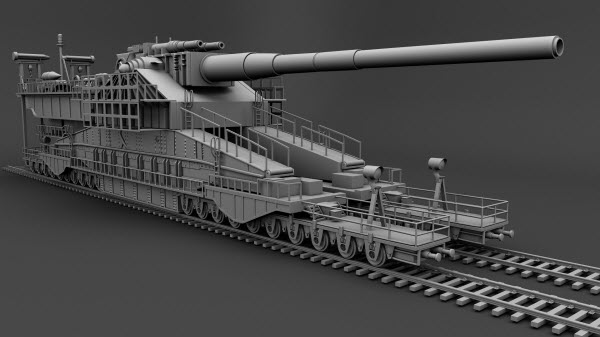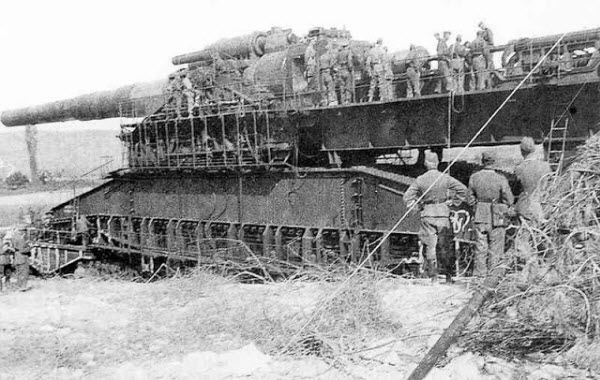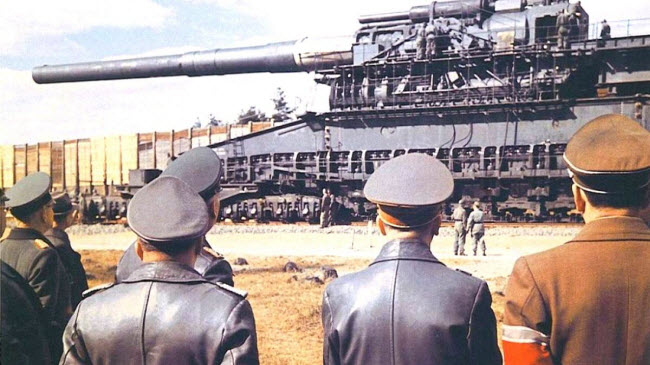Adolf Hitler was a megalomaniac, obsessed with colossal projects that showcased the power of the Third Reich. He demonstrated this before and during World War II through massive civil and military structures and the development of an array of oversized weapons and tanks that, despite their size, did not help him defeat the Allied armies. Although the list is extensive, the Schwerer Gustav, a giant cannon mounted on a railway carriage, holds one of the top spots. It was the largest piece of artillery in the entire conflict and was barely used for two weeks.
The concept for this design emerged shortly after the Nazi rise to power. As José Antonio Peñas Artero recalls in Máquinas de guerra (HRM Ediciones), an illustrated volume that details the main weapons and equipment used during the global conflict, it was Hitler himself who ordered the construction of the cannon in 1936 from Gustav Krupp von Bohlen, a powerful steel magnate who headed Krupp AG. Knowing that his foreign policy would eventually lead to a new war, Hitler needed a powerful machine capable of penetrating the seven meters of concrete of the Maginot Line, a fortified wall that France had erected along its border with Germany.
The budget for developing the gigantic cannon, which was 43 meters long, weighed nearly 1,400 tons, and had a caliber of 80 cm, was around ten million marks. For the same amount, 60 Tiger tanks could have been built. The complex machinery took longer than expected to assemble, and by the time it was ready for combat, the Nazis, who had not needed to breach the Maginot Line but instead bypassed it through Belgium, already controlled France. The Reich’s military leaders then decided to use their colossal weapon, which could fire seven-ton projectiles at a distance of 39 kilometers, in Operation Blue, the offensive on the Caucasus aimed at denying the Soviets access to the region’s oil resources.
The entire machine required 25 railway cars for transport and three weeks to assemble. According to Peñas Artero, it involved several thousand people to operate: “The crew of the weapon, i.e., the personnel responsible for its operation, consisted of 250 men, plus additional ones for transport, maintenance, and logistics. There were also troops assigned for ground protection and anti-aircraft defense [two battalions of FlaK 88]. The entire garrison assigned to the cannon was the size of a regiment, so the gun commander held the rank of colonel.”

The Gustav, which required the construction of a circular setup of two parallel tracks for aiming, was first used in June 1942 during the Siege of Sevastopol. Over the course of a week, it fired around fifty projectiles — it had a capacity to fire fourteen per day — and destroyed several forts and fortifications, including an underground ammunition depot located 30 meters deep near the sea. At the end of this battle, it was transported near Leningrad, where it was to be used again in the city’s siege. However, the Soviet counteroffensive thwarted these plans. According to some accounts, the cannon was fired again in 1944 on the outskirts of Warsaw.
Krupp AG would manufacture a second of these gigantic weapons, but it never saw combat. The Imperial War Museum’s website explains that Schwerer Gustav 2 was stored in 1943 at the Rügenwalde artillery range on the Polish coast, west of Gdansk. Hitler was fascinated by this prototype of a monstrous cannon, but its cost and limited use demonstrated that it was not very practical to spend so many resources on its creation.
Máquinas de guerra visually describes the land weapons (tanks, anti-tank guns, machine guns, submachine guns, pistols, armored and transport vehicles, etc.) used by the Allies and Axis troops during the Second World War. Despite the terror sown by the Panzer and Tiger tanks and the reliability of the MP40 submachine gun, the Nazi army, driven by that useless monumentalism that fascinated the Führer, developed other fanciful projects that contributed little to the war effort.
José Antonio Peñas Artero cites a few in his work, such as the Kristiansand fort in Norway, a massive concrete block with four-meter-thick walls intended to protect powerful artillery towers. The problem? The Allied landings occurred kilometers away.

In the realm of armored vehicles, there were two “hellish” examples: the Jagdtiger, an anti-tank vehicle that Hitler was confident could stop entire offensives and which never even reached the front — only 88 units were built — or the Rammtiger, equipped with an armored wedge-shaped superstructure to breach enemy fortifications and open the way for infantry. Three were built, and according to Heinz Guderian, Inspector General of Nazi Armored Forces, they were absurd vehicles that seemed designed for medieval duels.
In his obsession with developing an indestructible super-heavy war machine, Hitler greenlit Ferdinand Porsche to develop a tank close to two hundred tons, the Maus. “It was a giant version of Porsche’s Tiger project, as its engine was based on his hybrid power plan, combining a large gasoline engine with electric motors to power the tracks. The complexity of this system and the enormous surface area of the tracks required by such a massive vehicle meant that most of the hull was occupied by the engine,” explains Peñas Artero. 150 units were planned, but only a few were completed.
